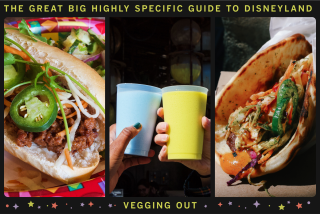Itinerary: Going Ape
- Share via
At first, creating ape food for the current “Planet of the Apes” seemed like an easy job for food stylist Jack White. Bananas and coconuts, right? Wrong. There would be no typical simian foodstuffs on this movie’s menu. Apparently he hadn’t seen “Escape From Planet of the Apes” (1971), in which Kim Hunter’ s Dr. Zira claims to “loathe bananas.” Set decorator Rosemary Brandenburg felt the same way about the new film’s food.
After viewing set drawings with Brandenburg, White set off on a search for “exotic, fun things that people hadn’t seen before. Stuff with lots of color.” The food had to be grillable over the film’s open fire pit but look good raw, too. Odd, knobby-skinned fruits and veggies were favored. This was, after all, a Tim Burton movie.
This weekend, become an apecurean. Track down some of Jack White’s finds and pack a sack with your veggie victuals. Then head to one of the many L.A.-area classic “Planet of the Apes” film locations for a picnic and a monkey moment.
Friday
Many bizarre edibles can be found in your local grocer’s exotic produce section. The ingredients for the apes’ stuffed banana leaves (which “can be stuffed with almost anything,” says White), gourds and cornmeal flapjacks are readily available. Cherimoya, a pink-fleshed fruit shaped like a melted artichoke and the orange spikey kiwano were in bowls on tables throughout the film. “Found ‘em at Ralphs,” says White.
The film’s grilled skewers were constructed from bitter melon, gourds and baby Japanese eggplant--all found at India Sweets and Spices (9409 Venice Blvd., Culver City, [310] 837-5286). White says, with a twinkle in his eye, that the bitter melons were a cast favorite.
Black radishes can be found at Marina Farms (5454 Centinela Ave., Mar Vista, [310] 827-3049). The market has a wide variety of offbeat produce. Also check out the many ethnic markets in the L.A. area for produce that is not familiar to the American eye.
Saturday
Head out to Malibu Creek State Park (1925 Las Virgenes Road, Calabasas, [818] 880-0367) for an ape-nic. The park was once owned by 20th Century Fox, and the elaborate sets for the original 1968 “Planet of the Apes” film were built near Century Lake at the park. It’s not hard to imagine loincloth-adorned Chuck Heston running for his life past the high rock formations.
Despite the popularity of the “Ape” sequels, the studio slashed the production budget for each film. To avoid costly sets, “Escape From the Planet of the Apes” was shot in the then-6-year-old planned community of Century City, which was sprouting up on the former Fox back lot. At the time, only the four buildings at the corner of Avenue of the Stars and Little Santa Monica Boulevard were in existence. The bridge over Avenue of the Stars from Century City Square (now Century City Shopping Center, 10250 Santa Monica Blvd., [310] 277-3808) was used extensively.
At the time, locals scoffed at the use of the Century City locations for a sci-fi movie. But to the rest of the moviegoing public, the modern buildings filled the bill.
Sunday
Nothing brings the ape-human relationship into focus more than a trip to the Los Angeles Zoo (5333 Zoo Drive, Griffith Park, [323] 644-6400, 10 a.m. to 6 p.m. daily. Adults, $8.50; kids 2-12, $3.25). Visit orangutans Bruno and Rosie at the Red Ape Rain Forest exhibit and spend some time pondering the differences and similarities between the big guys in the monkey suits and us. More than one visitor has left the zoo with an uneasy feeling that the apes know more than they’re telling.
More to Read
Only good movies
Get the Indie Focus newsletter, Mark Olsen's weekly guide to the world of cinema.
You may occasionally receive promotional content from the Los Angeles Times.










